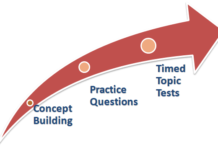The degree of control you have while solving a Reasoning question is a crucial aspect of decision making while attempting Reasoning questions.
My experience and observation of preparation trends and student processes used in solving reasoning questions tell me that most aspirants lose a degree of control they have on a question. Whether a question is within one’s grasp and one would be able to solve a question or not, is something that aspirants realize too late into the question.
By the time they realize that a question set was not worth investing the time, they would have already invested too much time in a futile attempt to solve the question.
In the question sets that appear as a part of the Reasoning in CAT and other non-CAT exams, realizing early whether a question set is going to get solved by you should be a crucial aspect of your preparation objectives.
Hence, the ability to pinpoint whether you would be able to solve a question set while you are going through it for the first time could be a big differentiator and could go a long way towards improving your test scores.
There are a few concrete steps you can specifically do for Reasoning:
(a) Work on developing an advanced warning system about the difficulty level of a question.
The problem that students face in segregating reasoning questions is that since they are all language intensive,
they all look the same. This is the reason test-takers face a problem in understanding whether a question set is to be solved or not.
(b) You would have to use all the information in most reasoning questions that you come across.
This assumption holds true because redundant data questions are very rarely found.
(c) The first thing you should look at in the question is the number of variables involved.
Typically, more the variables, more difficult the question is likely to be.
Given this, your approach to every reasoning question should be based on a sentence-by-sentence analysis of the question. Look at the clues closely and for each statement you come across, try to see whether it is a direct or an indirect clue. Direct clues would typically give you direct relationships between the variables involved and hence are easy to place (something like, “Amit is wearing the red shirt,” is a direct clue).
Indirect clues, on the other hand, are much more difficult to place and have to be used at specific points in solving a problem. (A typical indirect clue would read something like: “The person wearing the blue shirt lives somewhere to the right of the person who hates coffee and he is not Amar”)
Naturally, higher the proportion of direct clues, the easier the question would be. On the other hand, if the indirect clues are higher, the question starts becoming more and more difficult to solve and this single fact should go a long way towards helping you distinguish the tough reasoning questions from the easy ones.





